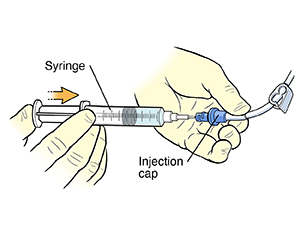Flushing Your Child’s PICC Line at Home
Your child’s peripherally inserted central catheter (PICC) line is used to deliver medicine or feedings. It’s a long, flexible tube (catheter) that goes into your child’s vein. To care for your child’s PICC line, you will need to flush it. This means you’ll need to clean it with a solution as directed by your child's healthcare provider. This keeps it from getting clogged or blocked. A clogged or blocked PICC line will need to be taken out and replaced.
When to flush the PICC line
You’ll need to flush your child’s PICC line as often as directed by their healthcare provider. You may need to flush it after each use. If the PICC line is not in active use, you may need to flush it once a day. Or you may only need to flush it once a week. Ask your child’s healthcare provider how often to do this.
What you’ll need
-
Flushing solution. This is the liquid that you will send through the PICC line. Your child’s healthcare provider will tell you what kind to use. In most cases, it is saline solution. This is a sterile mix of water and a tiny amount of salt. The healthcare provider will also tell you how much to use. You may also need to flush with a heparin solution after the saline. Heparin is a medicine that thins the blood. It helps prevent blood from clotting in and around the catheter.
-
A syringe. This is the device used to give an injection or shot. A syringe is used to flush your PICC line with solution. You will probably use prefilled syringes.
-
Alcohol wipes. Or you can use rubbing alcohol and cotton balls. You’ll use these to clean some of the tools used to flush the line. This helps to prevent germs from going into the PICC line.
-
Clean medical gloves.
How to flush your child’s PICC line
Repeat these steps as often as your child’s healthcare provider has instructed.
Skip steps 2 and 3 if you are using prefilled syringes.
Step 1. Wash your hands
-
Wash your hands well with soap and clean, running water for at least 20 seconds. Scrub your hands well, including the backs of your hands and between your fingers.
-
If you don’t have access to soap and water, use an alcohol-based hand gel. The gel should have at least 60% alcohol.
-
Put on a clean pair of medical gloves. Only touch your child’s PICC line when wearing clean gloves. This is to protect your child from infection.
Step 2. Fill the syringe
-
Open a new bottle of the flushing solution. If you’re using a bottle that’s already open, use the alcohol to clean the top of the bottle.
-
Remove the cap from the needle or tip of the syringe. Push the plunger of the syringe down all the way.
-
Put the needle or tip of the syringe into the flushing solution.
-
Pull the syringe plunger out. Stop when you have the right amount of flushing solution in the syringe. Your child’s healthcare provider will tell you how much to use.
Step 3. Remove air from the syringe
-
Hold the syringe with the tip pointing up.
-
Flick or tap the syringe with your finger. This will cause any large air bubbles to rise into the tip.
-
Slowly push on the plunger until a tiny drop of flushing solution comes out of the needle or tip. Put the cap back on the needle or tip of the syringe. This will keep it germ-free until you use it.
Step 4. Inject the flushing solution
-
Scrub the top and sides of the port (end of the catheter) with an alcohol wipe for 15 seconds. Scrub using a twisting motion as if juicing an orange. Let it dry completely. Prevent it from touching anything while drying. Don't blow on it. Don't reuse the alcohol wipe. Keep the port from touching anything until you connect the syringe. If you accidentally touch the port, clean it again.
-
Open the clamp, if there is one.
-
Take the cap off the needle or tip of the syringe. Insert the needle or tip into the port. Make sure you know if your child's PICC has a needleless connector. Talk to your child's provider if you aren't sure.
-
Push the plunger in slowly and smoothly. Don’t force the plunger. You shouldn’t feel any pressure when you push the fluid into the PICC line. If you do, stop right away. Call your child's healthcare provider right away.


Step 5. Finish flushing
When to call your child's healthcare provider
Call your child's healthcare provider right away if any of these happen:
-
Fever of 100.4°F or higher, or as advised by your child’s healthcare provider
-
Swelling, redness, fluid, or pain around the PICC site
-
Bleeding from the PICC site
-
Tubing that leaks or is pulling out
-
Medicine or fluids that do not drain from the bag into the PICC
-
You are not able to flush the PICC line
© 2000-2025 The StayWell Company, LLC. All rights reserved. This information is not intended as a substitute for professional medical care. Always follow your healthcare professional's instructions.